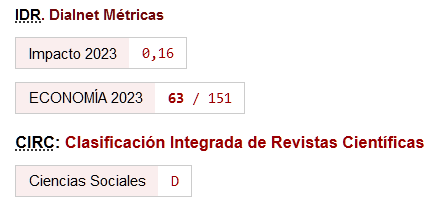Los problemas de la sobreacumulación en China
Palabras clave:
China, inversión, productividad, sobreproducción, tasa de gananciaResumen
La tasa de inversión de China alcanzó en 2009 un récord mundial, superando el 45% del PIB. Sin embargo, este proceso de acumulación puede ser peligroso para el mantenimiento de la inversión. El acento se pone a menudo en la importancia de los fenómenos de sobreproducción y de las capacidades de producción ociosas: la industria china funciona con sólo el 50 % de sus capacidades de producción. Ello tiene consecuencias sobre la productividad. Sin embargo, la evolución de la productividad puede ser también analizada a través de la teoría de de la tendencia decreciente de la tasa de ganancia, teoría presentada por Karl Marx en el tercer libro de El Capital.
Descargas
Citas
Aglietta, Michel y Landry, Yves (2007): La Chine vers la superpuissance, Paris, Economica, 176 págs.
Anderson, Jonathan (2007): "China should speed up the yuan's rise", in Far Eastern Economic Review, verano.
Artus, Patrick (2008): La Chine, Le Cercle des Economistes, Paris, Presses Universitaires de France, 93 págs.
Barnett, Steven y Brooks, Ray (2006): "What's driving investment in China", IMF Working Paper n° 265, noviembre, 39 págs.
https://doi.org/10.5089/9781451865257.001
Boutillier, Sophie y Uzinidis, Dimitri (1989): Chine, Questions sur l'ouverture aux multinationales, Paris, L'Harmattan, 157 págs.
Chang, Gordon (2001): The coming collapse of China, Nueva York, Random House, 344 págs.
Cieniewski S., Benaroya F. (2004): "Chine : la longue marche vers la société de prospérité moyenne", DREE dossiers, octubre, www.dree.org
Cieniewski, Stéphane (2005): "Les entreprises chinoises. Forces et faiblesses. Défis et perspectives", Article DREE, 14 diciembre, 7 págs., www.dree.org
Cieniewski, Stéphane (2006): "La profitabilité des entreprises chinoises", Fiches de Synthèse DREE, 28 abril, 7 págs., www.dree.org
Delozier, Benjamin y Hochraich, Diana (2006): "L'investissement en Chine est-il excessif?", in Economie et Prévisions, n° 173, febrero.
https://doi.org/10.3406/ecop.2006.7945
Eyraud, Corinne (1999): L'entreprise d'Etat chinoise, De l'institution sociale totale vers l'entité économique, Paris, L'Harmattan, 397 págs.
Felipe, Jesus y Xiaoqin Fan, Emma (2005): "The diverging patterns of profitability, investment and growth of China and India, 1980-2003", CAMA Working Paper Series 22/2005, The Australian National University, noviembre, 38 págs.
Gaulard, Mylène (2009): Accumulation du capital et inégalités : une approche comparée Chine/Brésil, Thèse de doctorat, Panthéon-Sorbonne, Paris, 570 págs.
Hay, Françoise y Yunnan, Shi (2006): La Chine : forces et faiblesses d'une économie en expansion, Renes, Presses Universitaires de Rennes, 411 págs.
He, Qinglian (1999): "China's latent economic crisis and potential risks", in Modern China Studies, vol. 65, n° 2.
Henry, Gérard-Marie (2006): Quand la Chine s'essoufflera : atterrissage en douceur ou crash, Studyrama, Levallois-Perret, 223 págs.
Hofman, Bert y Kujis, Louis (2006): "Profits drive China's boom", Far Eastern Economic Review, octubre, págs. 39-43.
Krugman, Paul (2000): Pourquoi les crises reviennent toujours, Paris, Seuil, 213 págs.
Kujis, Louis y Tao, Wang (2005): "China's pattern of growth: moving to sustainability and reducing inequality", China and the World Economy, vol. 14, n° 1, enero-febrero. https://doi.org/10.1111/j.1749-124X.2006.00003.x
Lardy, Nicholas (2006): "China : toward a consumption-driven growth path", Washington, Institute for International Economics, octubre. https://doi.org/10.2139/ssrn.2126152
Lin, Justin (2000): Le miracle chinois, stratégie de développement et réforme économique, Paris, Economica, 250 págs.
Lin, Justin, Fang Cai, Zhou Li (2007): "The Lessons of China's transition to a market economy", in The CATO Journal, vol. 16, n° 2.
Lindbeck, Assar (2006): "An Essay on Economic reforms and social change in China", World Bank Policy Research Working Paper, n° 4057, noviembre. https://doi.org/10.1596/1813-9450-4057
Maddison A. (1998): L'économie chinoise, une perspective historique, OCDE, Paris, 212 págs. https://doi.org/10.1787/9789264263550-fr
Marx, Karl (1972): Le Capital, Livre III, La Pléiade, Gallimard, Paris. [México, Fondo de Cultura Económica, vol. III, 1973].
Minqi Li (2003): "Aggregate demand, productivity, and disguised unemployment in the Chinese Industrial Sector", World Development, Vol. 32, n° 3, octubre, págs. 409-425. https://doi.org/10.1016/j.worlddev.2003.10.002
Nhu Nguyen Ngo (2006): "Chine: bilan social contrasté d'un formidable essor", BNP Paribas, Conjoncture, julio.
Palley, Thomas (2006): "External contradictions of the Chinese Development Model: export-led growth and the dangers of global economic contraction", Journal of Contemporary China, vol. 15, n° 46, febrero, págs. 69-88. https://doi.org/10.1080/10670560500331732
Perotti, Enrico y Sun, Laixiang (1998): "State-owned versus township and village enterprises in China", The United Nations University, World Institute for Development Economics Research, Working Paper n°150, septiembre, http://www.eldis.org/static/DOC7017.htm, 35 págs.
Plantade, Jean-Marc et Yidir (2006): La Face cachée de la Chine, Paris, Bourin Editeur, 284 págs.
Weijian, Shan (2006): "The World Bank's China delusions", in Far Eastern Economic Review, septiembre, págs. 29-32.
Weijian, Shan (2006): "China's low-profit growth model", in Far Eastern Economic Review, noviembre, págs. 23-28.
World Bank (1997): China 2020, Washington, World Bank, 161 págs.
Wu, Yanrui (1996): Productive performance in Chinese enterprises, Londres, Macmillan Press, 188 págs. https://doi.org/10.1057/9780230372535
Descargas
Publicado
Cómo citar
Número
Sección
Licencia
Esta licencia permite a terceros compartir (copiar y redistribuir el material en cualquier medio o formato) y adaptar (remezclar, transformar y crear a partir del material para cualquier finalidad, incluso comercial), siempre que se reconozca la autoría y la primera publicación en esta revista (La Revista, DOI de la obra), se proporcione un enlace a la licencia y se indique si se han realizado cambios en la obra.







